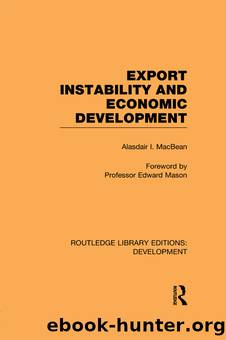Export Instability and Economic Development by Macbean Alasdair;

Author:Macbean, Alasdair;
Language: eng
Format: epub
ISBN: 614875
Publisher: Taylor & Francis Group
THE NURKSE THESIS
Source: Nurkse, 1958: p. 249. The argument is presented first on pp. 149â51 and then restated more precisely on pp. 247â50.
For a shift in demand from DD to DâDâ, supply expands from M to N, and total foreign-exchange earnings can be shown by a rectangle bounded by sides of length ON and NP2. If supply were held fixed, price would rise to P1 which lies below the equal revenue curve on which P2 is situated, OMâMP1 must be smaller than ONâNP2. Hence a fixed supply leads to a smaller gain from this rise in demand and price. Analogously a fall in demand shown by a shift from DâDâ to DD leads to exchange earnings OMâMP; while if supply were fixed at N, earnings would be ON-NP3 which falls below the equal revenue curve through P and hence is smaller.
The crucial assumptions for Nurkseâs conclusion are: (1) demand must be elastic above the point of the intersection of the D curve with the supply schedule and inelastic below it; (2) fluctuations must be the result, at least mainly, of change in demand; (3) relatively short-run elasticities of supply must be at least greater than zero and preferably rather high; (4) lagged responses of supply must not exist or must be amenable to controls.
The necessity for the first assumption can be easily verified from the diagram. If demand elasticity is less than unity above P2, the DâDâ curve will lie above the equal curve so that holding supply constant when demand increases will actually result in the greater earnings. Equally, if demand should be elastic below the point P, the DD curve will lie above the equal revenue curve through P; and if demand declines, a constant supply will again yield the higher earnings.
Nurkse defends this assumption by arguing that no rational country would charge a price for its exports which would move export operations on to the inelastic portion of the demand schedule, for it can gain by simply reducing exports and raising prices. He says, âA country would almost certainly not operate to the right of PM, since in that region the DD schedule has an elasticity of less than one, so that the country could increase its export income by reducing the quantity over that range of the demand schedule.â (1958: p. 248.) At most, this only takes care of inelasticity. It does not rule out the possibility that the DD schedule may be elastic in all of the range relevant to the problem. For many countries the demand facing their commodity exports is almost certain to be highly elastic simply because they supply such a small share of a relatively homogeneous market. But if demand is elastic, a downward or leftward shift of the DâDâ curve to DD would yield higher foreign-exchange earnings to a policy which fixed supply at N than to one which allowed supply to adjust back to M.
There are many other complicating features of this assumption. The policymakers have to know what
Download
This site does not store any files on its server. We only index and link to content provided by other sites. Please contact the content providers to delete copyright contents if any and email us, we'll remove relevant links or contents immediately.
International Integration of the Brazilian Economy by Elias C. Grivoyannis(91288)
The Radium Girls by Kate Moore(11921)
Turbulence by E. J. Noyes(7936)
Nudge - Improving Decisions about Health, Wealth, and Happiness by Thaler Sunstein(7615)
The Black Swan by Nassim Nicholas Taleb(7010)
Rich Dad Poor Dad by Robert T. Kiyosaki(6405)
Pioneering Portfolio Management by David F. Swensen(6226)
Man-made Catastrophes and Risk Information Concealment by Dmitry Chernov & Didier Sornette(5921)
Zero to One by Peter Thiel(5686)
Secrecy World by Jake Bernstein(4646)
Millionaire: The Philanderer, Gambler, and Duelist Who Invented Modern Finance by Janet Gleeson(4376)
The Age of Surveillance Capitalism by Shoshana Zuboff(4210)
Skin in the Game by Nassim Nicholas Taleb(4162)
Bullshit Jobs by David Graeber(4095)
The Money Culture by Michael Lewis(4076)
Skin in the Game: Hidden Asymmetries in Daily Life by Nassim Nicholas Taleb(3929)
The Dhandho Investor by Mohnish Pabrai(3699)
The Wisdom of Finance by Mihir Desai(3654)
Blockchain Basics by Daniel Drescher(3507)
